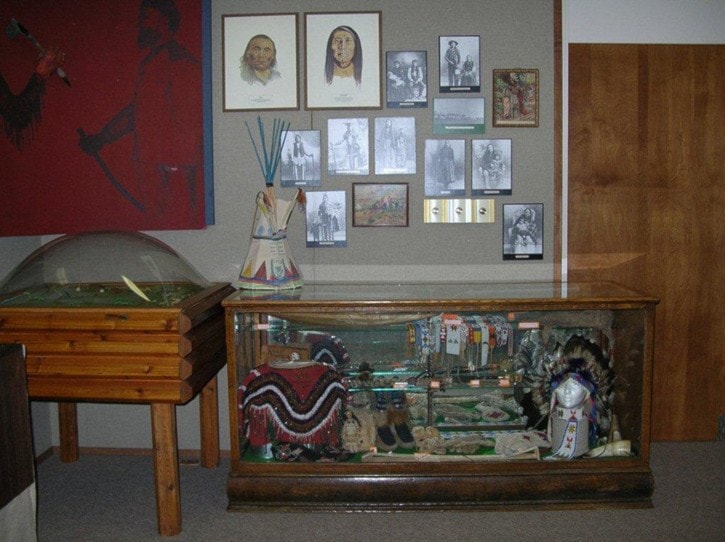Long before the arrival of the white man, the land surveyors and those hardy European explorers and their guides, the rugged and rolling Battle River country was inhabited by wandering tribes of Indians, and early records show that by 1730, this area in all directions was controlled by the Shoshoni or Snake Indians. At the beginning of the 1780s, however, the Peigans, a branch of the carefree but powerful Blackfoot tribe, had slowly moved in and taken possession of these lands.
They travelled and camped throughout the region, taking full advantage of the ample supplies of water, wood, wild berries, fruit, fish, game, and the vast herds of Buffalo, which were said to number over a million in the 17th century. The Blackfoot tribe, who were among the first to obtain rifles, used everything from their hunts, including the meat for food, the hides and fur for clothes, blankets, and shelter, and the bones and horns to make weapons and tools. In the early 1830s, they left the Battle River area for the southern plains, which made the way for the peaceful Cree Indians, who were attracted by the great numbers of beavers, which provided rich pelts for vital trade for supplies with the Hudson’s Bay Company.
On September 25, 1877, Chief Bobtail (Kiskayo) signed Treaty 6 with the Governor of the North West Territories, which gave the four Cree Bands (432 Indians) a reservation which ran from the ridge of Bear Hills southeast to the Battle River, and would be the humble beginnings of the Hobbema Reserve. The four original chiefs of what is now Maskwacis were Bobtail, Ermineskin, Muddy Bull and Samson, and during 1884-85, the joint boundaries of the Bobtail, Ermineskin, Montana, and Samson bands were established within the thousands of acres of reserve land. During the early days, the reserve schools were run by missionaries, then in 1929, the Hobbema School District No. 4445 was officially formed.
Over the years, the native families of the Hobbema agency became good friends and neighbours to the people of Ponoka and surrounding districts. Early photos in our history books show the Battle River Valley east of town full of teepees, horses and wagons on many occasions when the Indian tribes visited our community to trade and barter for goods, as well as performing their colorful and traditional dances of the buffalo hunting era in front of Alger’s Store on Railway Street, as well as at the annual Ponoka Stampede. Many members of the Hobbema tribes had become successful farmers and trappers, as well as working for the agency or throughout the reserves, which were complemented quickly by modern homes, churches, schools, businesses, recreation facilities and countless other amenities.
New Museum display features exciting native heritage.
An entire corner of the amazing display room at the Fort Ostell Museum in the Ponoka Lion’s Centennial Park has been dedicated to the long and colorful history of our First Nations people, as well as to the annual June celebration of Aboriginal Day in Canada. Featured in the antique showcases are many original photos of the early tribal chiefs and scenes from the late 18th century and beyond during the initial settlement of the native tribes throughout the Battle River Valley and on the Hobbema reserves. Some of these leaders, founders and heroes include Baptiste Saddleback, Sam and Robert Stoney, Paken and Poundmaker, Eva Cutknife, Bulse Samson, Tom Little Poplar, Bobtail, Muddy Bull and on and on throughout history.
Also featured for everyone to admire are traditional tribal head-dresses and war-bonnets superbly made by hand of eagle and turkey feathers and buffalo fur and horns; as well as moccasins and clothes blessed with magnificent beadwork and decorations; along with original drums, tools, weapons, skins, a pemican pounder, bows and arrowheads, and so much more. It is likely that most of us have only seen these age-old treasures in very old movies or history books, and they will be a treat for young and old. One of the most vivid publications depicting this often wild but proud and wonderful era of our early beginnings is ‘Chief Big Bear’, written by Demsey. Also in the writings from Captain Fort Ostell’s journal were the following comments: “On June 25, 1885 in the afternoon, Bobtail, Chief of the Crees came to visit the Fort (which was originally built where the historical sign is now located just south of Ponoka on highway 2A). Bobtail appeared to be about 60 years of age, and was accompanied by his wife and some young braves, one of whom was Woodpecker. The Chief, who was riding a magnificent steel grey mustang, has a very intelligent face, and when he spoke it seemed as though he was only half as old as we all thought. On his breast he wore a ‘Victoria’ medal of silver, and long feathers decorated his colorful seal-skin headdress.”
The congenial staff at the Fort Ostell Museum will be hosting their annual Heritage Tea on Saturday-August 1, 2015 from 1:00 p.m. to 5:00 p.m., with the theme of ‘Honouring the First Nation’s People’, and to which everyone is invited to attend and enjoy.
